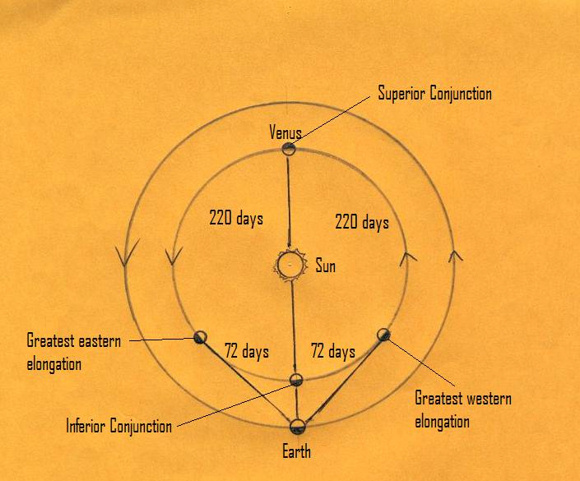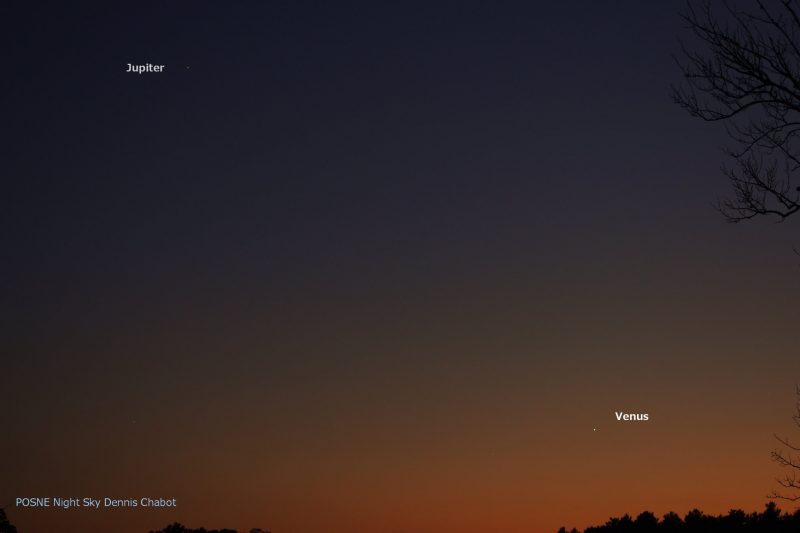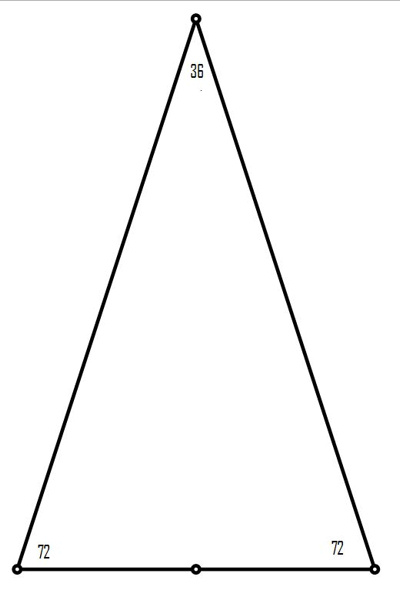
On and around September 20 and 21, 2018, look for the brightest planet, Venus, now looming low in the evening twilight, dazzlingly bright. It’s now Venus’ time of greatest brilliancy, a time when the planet takes on an odd appearance; many will report it as a UFO in the days ahead. It’s a precursor to Venus’ disappearance from our evening skies in the coming weeks.
Greatest brilliancy for Venus is a delicate balance between how much we see of the planet’s day side, and the changing distance between our 2 worlds.
Right now, the distance between us and Venus is decreasing, because Venus will pass between the Earth and sun on October 26. As a result, two things are happening to result in Venus at its brightest. First, Venus is waning in phase. Second, the disk of Venus is appearing larger in our sky.

There are 4 bright planets in the evening sky now. This image from Yuri Beletsky in Chile’s Atacama Desert shows them all. Venus is the brightest one, near the bottom of the image. Jupiter, Saturn and Mars extend upward in a line. Yuri wrote on September 10, 2018: “These nights, the sky is quite colorful in Atacama desert due to airglow. Here is the view of the Magellan telescopes of Carnegie Las Campanas Observatory under the stars. The bright cone of zodiacal light is also visible, just behind the telescopes … I hope you’ll enjoy the view!” Thank you, Yuri!
We see Venus as brightest when its daytime side, or illuminated side, covers its maximum area on our sky’s dome. That’s the case now. On September 20 and 21, 2018, Venus day side occupies more square area in our sky than at any time during its present apparition as the evening “star.” Astronomers will say that Venus will reach its greatest illuminated extent on September 21 at 10 UTC.
Venus always shines as the 3rd-brightest celestial body in Earth’s sky, after the sun and moon. However, Venus is about 2 1/2 times brighter at its brightest than at its dimmest.
Surprisingly, perhaps, Venus shines most brightly in our sky when its disk is about 25% illuminated in sunshine.

No, that’s not the moon. That’s a simulation of how Venus would appear in the telescope at its greatest illuminated extent (2018 September 21 at 10 UTC) via the US Naval Observatory.
Venus first entered the evening sky at superior conjunction (full phase) on January 9, 2018. Then it was relatively far across the solar system from us, and it appeared at a fuller phase.
Venus will pass between the Earth and sun on October 26, 2018. At that time, it will leave the evening sky to enter the morning sky. Astronomers call Venus’ passage between us and the sun an inferior conjunction of Venus.
At inferior conjunction, Venus is at the new phase. That is, as it passes between us and the sun, its day side is facing entirely away from us.
Venus exhibits its greatest illuminated extent about 36 days before – and after – inferior conjunction.

As Venus comes closer to passing between the Earth and sun on October 26, 2018, its phase will shrink but its disk size will enlarge. Here’s an example of how that looks from Statis Kalyvis.
Venus last reached its greatest eastern (evening) elongation (maximum angular separation) of 46 degrees from the setting sun on August 17, 2018. Venus will next reach its greatest western (morning) elongation of 47 degrees west of the rising sun on January 6, 2019.
At greatest elongation, Venus is approximately 50% illuminated in sunshine. A greatest eastern (evening) elongation takes place about 72 days before an inferior conjunction, and a greatest western (morning) elongation comes about 72 days after an inferior conjunction.

Earth and Venus orbit the sun counterclockwise as seen from the north side of the solar system. Venus reaches its greatest eastern elongation in the evening sky about 72 days before inferior conjunction and its greatest western elongation in the morning sky about 72 days after inferior conjunction. Greatest illuminated extent for Venus comes midway between a greatest elongation and an inferior conjunction.
Let the golden triangle help you to remember these Venus’ milestones. The two base angles equal 72o and the apex angle equals 36o. Quite by coincidence, Venus’ greatest elongations happen some 72 days before and after inferior conjunction, and Venus’ greatest illuminated extent happens some 36 days before and after inferior conjunction.
So watch for Venus now, at its brightest in our sky. For all of us on Earth, it’s in the west after sunset.
By the way, since it’s nearly autumn now for the northern half of the globe, the ecliptic – or path of the sun, moon and planets – makes a narrow angle with our sunset horizon. For us in the Northern Hemisphere, that fact keeps Venus low in our sky, while – in the Southern Hemisphere now – the opposite is true. At a latitude of 40 degrees north, Venus sets about one hour after sunset; at 40 degrees south latitude, in stark contrast, Venus sets a whopping 2 1/2 hours after the sun. Click here for a recommended almanac that’ll provide the setting times for the sun and Venus in your sky.
No time to look for Venus after sunset? Clouded out? Never fear. Venus will pass through its October 26 inferior conjunction and re-emerge in the morning sky. It’ll reach its greatest illuminated extent – and another greatest brilliancy – as the morning “star” on December 2, 2018.

Dennis Chabot of POSNE Night Sky in Massachusetts caught Venus and Jupiter on September 15, 2018. He wrote: “The sky is filled with planets tonight … just beautiful.”

Gianluca Masi of the Virtual Telescope Project in Rome, Italy caught Venus beside the St. Peter’s Dome and Basilica on September 15, 2018. Read his article: Venus retires from the evening sky.
Bottom line: Venus’ greatest illuminated extent occurs on September 21, 2018. It’s at and around this time that Venus shines most brightly in our sky. Watch for it!
from EarthSky https://ift.tt/2xrXQAG

On and around September 20 and 21, 2018, look for the brightest planet, Venus, now looming low in the evening twilight, dazzlingly bright. It’s now Venus’ time of greatest brilliancy, a time when the planet takes on an odd appearance; many will report it as a UFO in the days ahead. It’s a precursor to Venus’ disappearance from our evening skies in the coming weeks.
Greatest brilliancy for Venus is a delicate balance between how much we see of the planet’s day side, and the changing distance between our 2 worlds.
Right now, the distance between us and Venus is decreasing, because Venus will pass between the Earth and sun on October 26. As a result, two things are happening to result in Venus at its brightest. First, Venus is waning in phase. Second, the disk of Venus is appearing larger in our sky.

There are 4 bright planets in the evening sky now. This image from Yuri Beletsky in Chile’s Atacama Desert shows them all. Venus is the brightest one, near the bottom of the image. Jupiter, Saturn and Mars extend upward in a line. Yuri wrote on September 10, 2018: “These nights, the sky is quite colorful in Atacama desert due to airglow. Here is the view of the Magellan telescopes of Carnegie Las Campanas Observatory under the stars. The bright cone of zodiacal light is also visible, just behind the telescopes … I hope you’ll enjoy the view!” Thank you, Yuri!
We see Venus as brightest when its daytime side, or illuminated side, covers its maximum area on our sky’s dome. That’s the case now. On September 20 and 21, 2018, Venus day side occupies more square area in our sky than at any time during its present apparition as the evening “star.” Astronomers will say that Venus will reach its greatest illuminated extent on September 21 at 10 UTC.
Venus always shines as the 3rd-brightest celestial body in Earth’s sky, after the sun and moon. However, Venus is about 2 1/2 times brighter at its brightest than at its dimmest.
Surprisingly, perhaps, Venus shines most brightly in our sky when its disk is about 25% illuminated in sunshine.

No, that’s not the moon. That’s a simulation of how Venus would appear in the telescope at its greatest illuminated extent (2018 September 21 at 10 UTC) via the US Naval Observatory.
Venus first entered the evening sky at superior conjunction (full phase) on January 9, 2018. Then it was relatively far across the solar system from us, and it appeared at a fuller phase.
Venus will pass between the Earth and sun on October 26, 2018. At that time, it will leave the evening sky to enter the morning sky. Astronomers call Venus’ passage between us and the sun an inferior conjunction of Venus.
At inferior conjunction, Venus is at the new phase. That is, as it passes between us and the sun, its day side is facing entirely away from us.
Venus exhibits its greatest illuminated extent about 36 days before – and after – inferior conjunction.

As Venus comes closer to passing between the Earth and sun on October 26, 2018, its phase will shrink but its disk size will enlarge. Here’s an example of how that looks from Statis Kalyvis.
Venus last reached its greatest eastern (evening) elongation (maximum angular separation) of 46 degrees from the setting sun on August 17, 2018. Venus will next reach its greatest western (morning) elongation of 47 degrees west of the rising sun on January 6, 2019.
At greatest elongation, Venus is approximately 50% illuminated in sunshine. A greatest eastern (evening) elongation takes place about 72 days before an inferior conjunction, and a greatest western (morning) elongation comes about 72 days after an inferior conjunction.

Earth and Venus orbit the sun counterclockwise as seen from the north side of the solar system. Venus reaches its greatest eastern elongation in the evening sky about 72 days before inferior conjunction and its greatest western elongation in the morning sky about 72 days after inferior conjunction. Greatest illuminated extent for Venus comes midway between a greatest elongation and an inferior conjunction.
Let the golden triangle help you to remember these Venus’ milestones. The two base angles equal 72o and the apex angle equals 36o. Quite by coincidence, Venus’ greatest elongations happen some 72 days before and after inferior conjunction, and Venus’ greatest illuminated extent happens some 36 days before and after inferior conjunction.
So watch for Venus now, at its brightest in our sky. For all of us on Earth, it’s in the west after sunset.
By the way, since it’s nearly autumn now for the northern half of the globe, the ecliptic – or path of the sun, moon and planets – makes a narrow angle with our sunset horizon. For us in the Northern Hemisphere, that fact keeps Venus low in our sky, while – in the Southern Hemisphere now – the opposite is true. At a latitude of 40 degrees north, Venus sets about one hour after sunset; at 40 degrees south latitude, in stark contrast, Venus sets a whopping 2 1/2 hours after the sun. Click here for a recommended almanac that’ll provide the setting times for the sun and Venus in your sky.
No time to look for Venus after sunset? Clouded out? Never fear. Venus will pass through its October 26 inferior conjunction and re-emerge in the morning sky. It’ll reach its greatest illuminated extent – and another greatest brilliancy – as the morning “star” on December 2, 2018.

Dennis Chabot of POSNE Night Sky in Massachusetts caught Venus and Jupiter on September 15, 2018. He wrote: “The sky is filled with planets tonight … just beautiful.”

Gianluca Masi of the Virtual Telescope Project in Rome, Italy caught Venus beside the St. Peter’s Dome and Basilica on September 15, 2018. Read his article: Venus retires from the evening sky.
Bottom line: Venus’ greatest illuminated extent occurs on September 21, 2018. It’s at and around this time that Venus shines most brightly in our sky. Watch for it!
from EarthSky https://ift.tt/2xrXQAG


Aucun commentaire:
Enregistrer un commentaire